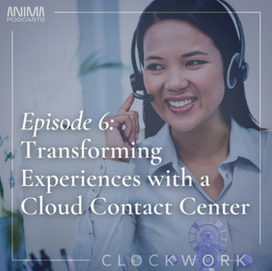To keep up with an increased demand for timely, efficient, and effective customer service, enterprises are now tapping contact-center-as-a-service (CCaaS) solutions. Through this cloud-based method of managing customer relationships, businesses can use a cloud contact center provider’s software instead of maintaining their own costly IT servers and manpower.
At the height of the pandemic, many Business Process Outsourcing (BPO) companies abroad have moved to a cloud-based, work-from-home model. With employees working remotely, businesses had to look for ways to deploy applications that enable secure, cost-efficient, and productive work outside office premises. This accelerated the adoption of cloud-based solutions which, in turn, facilitates customer service across multiple channels such as voice, SMS, email, and even social media.
These are just some of the customer experience trends discussed in the latest episode of CLOCKWORK, a Globe Business podcast that examines the gears that make businesses tick. Hosted by Peter Maquera, Senior Vice President for Globe Business, Enterprise Group, CLOCKWORK provides listeners with meaningful and humanized conversations about business, tech, and industry insights.
In this episode, Maquera talks with Assaf Tarnopolsky, Senior Vice President and General Manager for the Asia Pacific at Genesys, a leader in cloud customer experience orchestration. They discuss how customer experience has evolved through the years and how cloud contact centers are relevant in today’s hyper-digital world. Genesys is Globe’s partner in delivering the Globe Omnichannel (GO) Cloud Contact Center, an easy-to-use and fast-to-deploy Contact Center as a Service (CCasS) solution for enterprises.
The future of contact centers
With cloud contact centers, BPO agents get a 360-degree view of customers, and all customer interactions, whether they occur via voice, chat, email, social media, or even messaging. If a customer calls after sending an email, an agent will be able to read that email and all previous interactions with that particular customer. This allows them to become better equipped to solve customer issues within shorter call hold times, thereby increasing engagement and improving communication with customers.
Cloud-based contact centers, such as the GO Cloud Contact Center, can support today’s hybrid work setups, allowing agents to work from any location and securely access the customer information they need within a single, intuitive platform.
Security at all touchpoints
Security is no longer a nice-to-have add-on but rather a necessary built-in feature for digital technologies, especially for contact centers handling the sensitive data of large enterprises such as banks and other financial institutions, healthcare companies, and even government offices. “Security is the foundation and must be at the core of what we do to elicit customer trust. The key is to deliver meaningful, empathetic, and personalized experiences to serve customers better at every step,” shared Tarnopolsky.
With the GO Cloud Contact Center, enterprises can trust that their customer and business data will remain secure. The GO Cloud Contact Center meets and exceeds modern security standards with external penetration testing, attack defense automation, and TLS and AES-256 encryption, the gold standard in symmetric-key encryption techniques.
Making the shift to the cloud
The work-from-home contact center model is likely to be adopted over the long term. As such, it makes more sense to invest in cloud-based contact centers rather than in legacy platforms, which tend to be more maintenance and labor-intensive. Comparatively, a cloud contact center boasts of fast deployment, easy integration, flexible pricing, and scalability.
“With GO Cloud Contact Center, for example, businesses can deploy customer organization systems in days, go live in mere weeks, and reach payback in no time. And with new system releases every week, you can also give customers the latest functionality with just a simple refresh, without any downtime for updates,” said Maquera.
Cloud-native solutions usually work in a pay-per-use model, which allows optimization features, functionalities, and services when needed. This lends more flexibility and cost-effectiveness compared to traditional, on-premise legacy platforms which tend to over-provision, wasting company resources in the process.
“It is a business imperative for a lot of companies to optimize their relationship with the customers by reimagining customer touchpoints and delivering valuable experiences throughout their journey. They must recognize how they engage with customers will impact their brand value and how customers perceive them. This will eventually impact an organization’s ability to thrive and grow in the future and differentiate in the marketplace,” adds Tarnopolsky.
As your trusted business partner, Globe Business remains steadfast in its commitment to providing compelling ICT services that move your digital transformation journey forward. Globe strongly supports the United Nations Sustainable Development Goals, particularly UN SDG No. 9, which highlights the roles of infrastructure and innovation as crucial drivers of economic growth and development. Globe is committed to upholding the UN Global Compact principles and contributes to 10 UN SDGs.
To know more about Globe Omnichannel (GO) Cloud Contact Center, visit our website or get in touch with your Enterprise Account Manager today.
 For more business insights from industry experts and enterprise executives, listen to the CLOCKWORK podcast by Globe Business—now streaming on Spotify.
For more business insights from industry experts and enterprise executives, listen to the CLOCKWORK podcast by Globe Business—now streaming on Spotify.